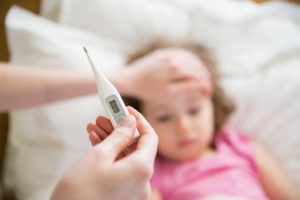The hip is not yet fully developed in about 2% to 3% of babies at birth. The socket is then flattened, and the head of the femur is not firmly seated in the socket. Until the hip is fully developed, your child wears spreader pants over his or her clothing. How long does your child have to wear the orthosis?
In this article, you’ll learn everything you ever wanted to know about spreader pants.
Table of contents
Spreader Pants For Hip Dysplasia Prevent Hip Joint Arthrosis
Especially in multiple pregnancies and in the case of breech presentation, it often happens that the child’s hip is not yet fully developed. This means that the socket is flattened to such an extent that the head of the femur does not sit firmly in the socket.
The bones slip and shift against each other with every movement. This can cause painful inflammation of the hip joint even in young children. Then one speaks of a hip joint arthrosis.
This can be prevented with a spreader pant for the baby: The spreader pants are worn over clothing. They consist of a firm plastic shell that keeps your child’s legs spread out to the side.
If your child wears this orthosis consistently, the hip can mature. This means that the joint develops completely. This usually takes a few months. After that, your child will probably no longer need to wear the spreader pants.
The hip examination is one of the preventive examinations that your baby should have anyway. The health insurance companies pay for these check-ups at the pediatrician.
If such an examination reveals that your child may suffer from hip dysplasia, the doctor will order an ultrasound examination of the hip. Ultrasound allows the doctor to get an accurate picture of the hip. The hip joint becomes visible on the computer image.
If hip dysplasia really exists, you and your child will be sent to an orthopedist. There, your child will be prescribed a pair of spreader pants. The padded plastic shell is paid for by the health insurance. Your child wears the baby pants over his or her normal clothes, including diapers.
Skeletal Malformations Are Not That Rare
It is actually more common for children to be born with mild or even severe skeletal malformations. Hip dysplasia occurs in 2% to 3% of all newborns, making it the most common skeletal malformation in children.
Girls are affected more often than boys. However, it is still not clear why this is so. Hormonal factors are suspected as the cause. It is rare for the head of the femur to actually slip completely out of the socket.
If this happens, it is called a hip dislocation. Only 0.2% of all newborns are affected by such an extreme deformity. Hip dysplasia can be hereditary. However, it is favored by an unfavorable position in the womb during pregnancy.
If children are born from a breech or pelvic end position, they are 25 times more likely to be affected by this malformation. In multiple pregnancies, these malformations occur due to the confinement in the womb.
And another reason may be the pregnancy hormone progesterone. This is produced by the mother’s body to prepare the pelvic ring for birth. However, the hormone also acts in the baby’s body and can cause more loosening of the hip joint capsule. Female babies are likely to have a stronger reaction to it.
If your baby’s hip is not fully formed, stretching after birth can harm your baby’s hip. Even if the pediatrician has not diagnosed hip dysplasia or sees only a slight delay in the maturity of the hip, you should rather carry your child in the squat-spread position.
In this position, your baby’s legs are spread apart like in splay pants, and the knees are bent. Your child usually assumes this posture, which is a bit reminiscent of a frog, when lifting up anyway.
How Does A Baby’s Spreader Pants Work?
Around the clock, the spreader pants should stay on the baby. Like any other medical orthosis, the spreader pants can correct the bone position only if they are worn permanently. The spreader pants keep your baby’s legs at the correct angle to the hip socket.
Therefore, the head of the femur cannot slip while your baby is wearing the spreader pants. Normally, your baby’s legs are splayed out to the side at an angle of 90° or 100° when wearing the spreader pants.
If hip dysplasia is present, the body itself will try to correct the misalignment. Thus, the hip is still rebuilt in any case. However, this can only happen in an anatomically sensible way if your baby keeps its legs reasonably still. The femur should always be in the same place in the socket.
And this is exactly what the spreader pants help the baby to do: It can move its legs, but it cannot move the bones in the hip against each other. It usually takes about eight weeks after birth for the hip to fully mature.
Until then, your baby must wear the spreader pants. The pediatrician will check the hip again and again during these weeks. An ultrasound examination will show whether the hip dysplasia still exists.
The spreader pants in the baby are useful because they hold the thigh bone firmly in the socket of the hip. This allows the socket to form correctly around the bone. But the spreader pants have another effect: they stretch the ligaments, muscles, and tendons so much that they can no longer pull the condyle out of the socket of the hip joint.
Why Is The Spreader Pants So Important For The Baby?
Hip dysplasia can actually only be corrected by wearing the spreader pants. If your baby’s hip does not form correctly, your child will have many problems with the hip later. The bones will become inflamed, again and again, your child will have problems learning to walk.
He or she will develop bad posture and back problems. Many children develop very painful hip arthritis at a young age. Wearing a spreader pant can save the baby from all of this.
Ultrasound examination of the hip is also called sonography. It has been used since the 1970s. The spreader pants did not exist in the past: in the 1960s and 1970s, special diaper pants were recommended to parents to prevent hip joint malformation if hip dysplasia might exist.
Hip dysplasia does not always lead to deformities, and even these can be more or less corrected by surgery. However, it is always gentler for your child to prevent malformations with an orthosis. By the way, the spreader pants are also known as the Tübingen hip flexor splint.
Every baby grows at a different pace. Your child also develops individually. This also applies to the maturity of the hips. It is impossible to say in advance exactly how long the spreader pants will accompany the baby. Therefore, regular hip examinations are necessary over the next few months to observe the development.
Most babies wear their spreader pants for a few months and no longer need them when they learn to crawl and walk. For adults, the spreader pants take some getting used to at first, but children get used to the orthosis very quickly. They are soon no longer bothered by it.
Hip Deformities Are Usually Not Painful
If your baby’s hip is not fully developed, this is not associated with pain at first. However, your child cannot move his or her legs properly because of the deformity. In most cases, children cannot spread their legs properly; they develop an inhibition of spreading.
This can be an indication of hip dysplasia. Sonography, or at least a very close examination of the hip joint, is part of U2 and U3. If the hip deformity is so severe that the femoral head has already slipped out of the socket, on the other hand, you will recognize this immediately.
In the case of a hip luxation, the affected leg is slightly shorter. The posterior femoral folds are not symmetrical. However, this is only the case if only one side of the hip is affected. If both sides are affected, you will not see this. Because then the hip is symmetrically formed again, the folds are the same and the legs are the same length.
Often, when changing the child’s diaper, parents notice that something is wrong. The children do not move the two legs equally, are more mobile on one side than on the other. Many children adopt a protective posture, do not fold the affected leg as far to the side. If you observe this in your child, you should ask your pediatrician about it.
Spreading pants are only used to treat more serious malformations, which are also discovered early. If a slight delay in hip development is detected in the first weeks of your child’s life, he or she will not usually be prescribed a spreader pants. Instead, you will receive recommendations for everyday life:
- It is good for your child to sit in the diary. The correct squat spread position helps the hip to mature healthily.
- Avoid stretching your child’s hips. Do not swaddle your baby.
- Swaddle your baby so that the hips are always flexed. This works very well with cloth diapers. In the past, people used to talk about swaddling children wide: A wide folded gauze cloth or collection cloth was additionally placed in the crotch so that the baby cannot stretch the legs.
- Do not put your baby on the stomach too early and especially not often.
However, if the deformity is not detected until between the second and fourth week of life, or if it is very severe, the baby will certainly be prescribed the spreader pants. If the baby wears the spreader pants consistently, the hip dysplasia will regress within a few weeks.
In the case of hip dislocation, on the other hand, your baby may have to wear a cast for several weeks. In some cases, surgery may even be necessary.
Are There Alternatives To Spreading Pants For The Baby?
One alternative has already been mentioned: In the case of mild hip dysplasia, it may be sufficient to wrap your baby wide, carry him or her in a sling in the tuck-spread position, and avoid a stretched position. Sometimes, however, hip dysplasia is so severe that this is not enough.
In this case, the doctor may prescribe a spreading splint for your baby instead of spreading pants. This splint is also worn over the underwear, but it does not go completely around the baby’s bottom and the entire hip.
Instead, the splint lies on the inside of the thighs and fixes the thighs in this position. A splint like this doesn’t bother your baby any more than a pair of spreader pants. For parents, on the other hand, it is often hard to bear when the child has to wear a cast.
But babies are usually not very impressed by this either. And the cast will also fix the hip in a secure position so that the hip can mature.
Sources
https://praxistipps.focus.de/spreizhose-fuer-baby-in-diesen-faellen-ist-die-orthese-sinnvoll_107147










